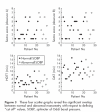Scintigraphy versus manometry in patients with suspected biliary sphincter of Oddi dysfunction
- PMID: 12584215
- PMCID: PMC1773549
- DOI: 10.1136/gut.52.3.352
Scintigraphy versus manometry in patients with suspected biliary sphincter of Oddi dysfunction
Abstract
Introduction: Sphincter of Oddi (SO) manometry is at present the "gold standard" investigation for patients with suspected biliary SO dysfunction. Non-invasive scintigraphy in cholecystectomised patients using a complex scoring system or the transit time from the hepatic hilum to the duodenum (HDTT) have been promoted as sensitive and specific alternatives.
Aim: To evaluate the scintigraphic scoring system and HDTT in patients with suspected biliary SO dysfunction undergoing SO manometry.
Methods: Cholecystectomised patients undergoing SO manometry for persistent biliary-type pain, as defined by the Rome II criteria, for which all other causes had been excluded, were prospectively studied. Scintigraphy with cholecystokinin octapeptide infusion was performed within a month prior to manometry. Scoring of the scans and measurement of HDTT was performed by independent blinded observers. Manometry of the biliary sphincter was performed per-endoscopically and defined as abnormal if basal pressure was > or = 40 mm Hg.
Results: Thirty two patients were enrolled (30 females, mean age 45.1 years). Three patients were excluded from analysis because manometry from the bile duct was not technically possible. Eight patients had abnormal manometry. Scintigraphic scoring had a sensitivity of 25-38%, a specificity of 86-89%, positive predictive value (PPV) of 40-60%, and a negative predictive value (NPV) of 75-79%. The coefficient of variation for interobserver variation in scores was 0.72. HDTT sensitivity was 13%, specificity 95%, PPV 50%, and NPV 74%.
Conclusions: Our findings indicate that scintigraphy using these methods of analysis correlates poorly with manometry in post cholecystectomy patients with suspected biliary SO dysfunction.
Figures



Comment in
-
Is hepatobiliary scintigraphy insensitive for the diagnosis of sphincter of Oddi dysfunction?Gut. 2003 Sep;52(9):1385-6. doi: 10.1136/gut.52.9.1385-b. Gut. 2003. PMID: 12912878 Free PMC article. No abstract available.
-
Scintigraphic assessment of SO dysfunction.Gut. 2003 Nov;52(11):1655-6. doi: 10.1136/gut.52.11.1655. Gut. 2003. PMID: 14570739 Free PMC article. No abstract available.
References
-
- Geenen JE, Hogan WJ, Dodds WJ, et al. Intraluminal pressure recording from the human sphincter of Oddi. Gastroenterology 1980;78:317–24. - PubMed
-
- Scicchitano J, Saccone GTP, Baker RA, et al. How safe is endoscopic sphincter of Oddi manometry. J Gastroenterol Hepatol 1995;10:334–6. - PubMed
-
- Maldonado ME, Brady PG, Mamel JJ, et al. Incidence of pancreatitis in patients undergoing sphincter of Oddi manometry (SOM). Am J Gastroenterol 1999;94:387–90. - PubMed
Publication types
MeSH terms
Substances
LinkOut - more resources
Full Text Sources
